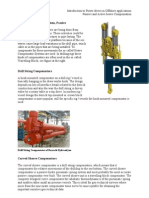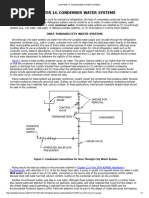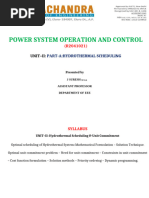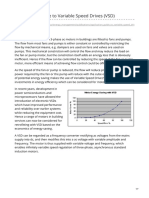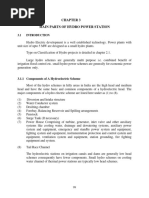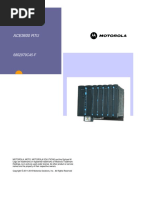The Emergency Storage
The Emergency Storage
Uploaded by
bwlhytrqyt054Copyright:
Available Formats
The Emergency Storage
The Emergency Storage
Uploaded by
bwlhytrqyt054Original Title
Copyright
Available Formats
Share this document
Did you find this document useful?
Is this content inappropriate?
Copyright:
Available Formats
The Emergency Storage
The Emergency Storage
Uploaded by
bwlhytrqyt054Copyright:
Available Formats
The emergency storage, Vemer, can be taken as the average daily demand, in which case Vemer =
250,000 * 600 = 150 * 106 L = 150,000 m3 The required volume, V, of the service reservoir is
therefore given by V = Vpeak + Vfire + Vemer = 67, 500 + 20, 100 + 150, 000 = 237,600 m3 The
service reservoir should be designed to store approximately 238,000 m3 of water. This large volume
will require a ground storage tank (recall that the largest elevated-tank volume in the United States is
15,520 m3), and it is interesting to note that most of the storage in the service reservoir is reserved
for emergencies. EXAMPLE 3.5 A water-supply system is to be designed in an area where the
minimum allowable pressure in the distribution system is 300 kPa. A hydraulic analysis of the
distribution network under average-daily-demand conditions indicates that the head loss between
the low-pressure service location, which has a pipeline elevation of 5.40 m, and the location of the
elevated storage tank is 10.0 m. Under maximum-hourlydemand conditions, the head loss between
the low-pressure service location and the elevated storage tank is 12.0 m. Determine the normal
operating range for the water stored in the elevated tank. Solution Under average-daily-demand
conditions, the elevation z0 of the hydraulic grade line (HGL) at the reservoir location is given by z0 =
pmin γ + zmin + hL where pmin = 300 kPa, γ = 9.79 kN/m3, zmin = 5.40 m, and hL = 10.0 m, which
yields z0 = 300 9.79 + 5.4 + 10.0 = 46.0 m Under maximum-hourly-demand conditions, the elevation
z1 of the HGL at the service reservoir is given by z1 = 300 9.79 + 5.4 + 12.0 = 48.0 m Therefore, the
operating range in the storage tank should be between elevations 46.0 m and 48.0 m. It is important
to keep in mind that the best hydraulic location and most economical design are not always the
deciding factors in the location of an elevated tank. In some cases, the only acceptable location will
be in an industrial area or public park. In cases where public opinion is very strong, a water utility
may have to construct ground-level storage, which is more aesthetically acceptable. 3.4 Performance
Criteria for Water-Distribution Systems The primary functions of water-distribution systems are to:
(1) meet the water demands of users while maintaining acceptable pressures in the system; (2)
supply water for fire protection at specific locations within the system, while maintaining acceptable
pressures for normal service throughout the remainder of the system; and (3) provide a sufficient
level of redundancy to support a minimum level of reliable service during emergency conditions,
such as an extended loss of power or a major water-main failure. Real-time operation of water-
distribution systems is typically based on remote measurements of pressures and storage-tank water
levels within the distribution system. The pressure and water-level data are typically transmitted to a
central control facility via telemetry, and adjustments to the operation of the distribution system are
made from the central facility by remote control of pumps and valves within the distribution system.
These electronic control systems are generally called supervisory control and data acquisition
(SCADA) systems. Operating criteria for service pressures and storage facilities are described below.
You might also like
- Ventilation Calculation Indoor PoolsDocument12 pagesVentilation Calculation Indoor Poolsvalentinlupascu33100% (1)
- UM-00019B - Apollo 3 Intelligent Control System User ManualDocument277 pagesUM-00019B - Apollo 3 Intelligent Control System User Manualcristian leonNo ratings yet
- M5 Pumps and StorageDocument20 pagesM5 Pumps and StorageandreinarodNo ratings yet
- Electro-Mechanical Water Pump Supply Design AnalysisDocument21 pagesElectro-Mechanical Water Pump Supply Design Analysisbekele100% (1)
- Dse7200 Dse7300 Series Configuration Suite PC Software ManualDocument122 pagesDse7200 Dse7300 Series Configuration Suite PC Software ManualKrisada Thongkamsai100% (1)
- 2 Storage Facilities2 2019.07.08Document3 pages2 Storage Facilities2 2019.07.08Jonathan Jr TejadaNo ratings yet
- Lecture 8 Storage TanksDocument28 pagesLecture 8 Storage Tanksbaruhiye0020No ratings yet
- Distribution ReservoirsDocument14 pagesDistribution ReservoirsBinyam KebedeNo ratings yet
- PlumbingDocument62 pagesPlumbingyildyusuf100% (2)
- Hasang Hydro Power PlantDocument62 pagesHasang Hydro Power PlantMark Jayson Baes NamucoNo ratings yet
- Minimum Tailings Storage CostDocument3 pagesMinimum Tailings Storage CostRenzoNo ratings yet
- US FEMP Water Efficiency For LaboratoriesDocument12 pagesUS FEMP Water Efficiency For LaboratoriesjuruterasamNo ratings yet
- Modern Refrigeration and Air Conditioning para El TestDocument7 pagesModern Refrigeration and Air Conditioning para El TestRenan GonzalezNo ratings yet
- Principles of Engineering AssignmentDocument19 pagesPrinciples of Engineering Assignmentsamuelakintokun00No ratings yet
- Two Cascade Dams or One Higher DamDocument4 pagesTwo Cascade Dams or One Higher DamSiamak HashempourNo ratings yet
- DumpfloodDocument16 pagesDumpfloodhifni98No ratings yet
- PumpDocument8 pagesPumpNayanika ChaudhariNo ratings yet
- Cooling TowersDocument38 pagesCooling TowersMohamed M. Abdul SamieNo ratings yet
- Design and Analysis of Firewater Network For A Tataouine Gas Processing PlantDocument11 pagesDesign and Analysis of Firewater Network For A Tataouine Gas Processing PlantHedi Ben MohamedNo ratings yet
- Albers TUDelft Introduction, Heave CompensationDocument17 pagesAlbers TUDelft Introduction, Heave Compensationnvkurup100% (1)
- Simulating Cooling Water Circuit Dynamics: Mentor Graphics, Mechanical Analysis DivisionDocument8 pagesSimulating Cooling Water Circuit Dynamics: Mentor Graphics, Mechanical Analysis DivisionobumuyaemesiNo ratings yet
- Ppe Project.Document8 pagesPpe Project.bagwanhaji644No ratings yet
- Hydropower Engineering I-6812Document84 pagesHydropower Engineering I-6812Arus Edo100% (1)
- Water Reticulation ConsiderationDocument3 pagesWater Reticulation ConsiderationQayyum Uzear UsinNo ratings yet
- AVCN2Document4 pagesAVCN2Lộc Nguyễn Sỹ QuýNo ratings yet
- Mech 5Document3 pagesMech 5mitch111319No ratings yet
- Mech CDocument7 pagesMech Cmitch111319No ratings yet
- Calculating HeadDocument1 pageCalculating HeadSanjana ValapilNo ratings yet
- Isolation, Gas Freeing & Reinstate Procedures (PTP-8) Training Package PTP 8.2 Equipment IsolationDocument20 pagesIsolation, Gas Freeing & Reinstate Procedures (PTP-8) Training Package PTP 8.2 Equipment IsolationJayNo ratings yet
- Dynamic Simulation Example Invensys PDFDocument6 pagesDynamic Simulation Example Invensys PDFdigecaNo ratings yet
- Chapter 14. Condenser Water SystemsDocument7 pagesChapter 14. Condenser Water SystemsYahya AyeshNo ratings yet
- Slide 1 - There Are Many Different Types of Circuit Breakers and Many Different System Conditions Where They May Be AppliedDocument7 pagesSlide 1 - There Are Many Different Types of Circuit Breakers and Many Different System Conditions Where They May Be AppliedHüseyin AkdoğanNo ratings yet
- Vw1004 Control KosoDocument27 pagesVw1004 Control KosolovelycatNo ratings yet
- Ar002Document28 pagesAr002Pedro Tiago Batista CoelhoNo ratings yet
- LPG Fire Protection System-Lpg Opn Trainee-12nov18Document13 pagesLPG Fire Protection System-Lpg Opn Trainee-12nov18Ankit JonwalNo ratings yet
- Taller2 - Seleccion de ChillerDocument3 pagesTaller2 - Seleccion de ChillerAlexStevenNo ratings yet
- Pumphouse: Station Design and LayoutDocument34 pagesPumphouse: Station Design and LayoutAswindana Ibnu SenaNo ratings yet
- D/B Emergency Operations Center (Eoc) and Disaster Relief Warehouse (DRW) at Chachapoyas And, D/B Eoc/DrwDocument10 pagesD/B Emergency Operations Center (Eoc) and Disaster Relief Warehouse (DRW) at Chachapoyas And, D/B Eoc/DrwPiero Gonzales VasquezNo ratings yet
- Underground Piping and Services SystemsDocument29 pagesUnderground Piping and Services SystemsNabil Al-Khirdaji50% (2)
- Production Control SystemsDocument12 pagesProduction Control SystemsTony EduokNo ratings yet
- Eservoir AND Distribution System: Hapter SevenDocument30 pagesEservoir AND Distribution System: Hapter SevenSandesh KhadkaNo ratings yet
- Unit 02 PsocDocument103 pagesUnit 02 Psocsmilyraghava123No ratings yet
- Icecs 2002 Cd-Rom Proceedings: Welcome To TheDocument5 pagesIcecs 2002 Cd-Rom Proceedings: Welcome To TheosamahNo ratings yet
- SPIS Technical Design Manual Part3Document30 pagesSPIS Technical Design Manual Part3Rasak AdepojuNo ratings yet
- Hydro Power PlantsDocument6 pagesHydro Power PlantsSaurav KumarNo ratings yet
- Design of Water-Distribution SystemsDocument59 pagesDesign of Water-Distribution SystemsCesNo ratings yet
- Hydraulics Experiment 7Document9 pagesHydraulics Experiment 7Allen Jesse Alfonso AtanacioNo ratings yet
- Microelectricity Generation From Higher Head Water TanksDocument8 pagesMicroelectricity Generation From Higher Head Water TanksshohiNo ratings yet
- Epa Bum Ch9 HvacDocument23 pagesEpa Bum Ch9 Hvaccesar luis gonzalez rodriguezNo ratings yet
- Emsd - Gov.hk-Application Guide To Variable Speed Drives VSD PDFDocument7 pagesEmsd - Gov.hk-Application Guide To Variable Speed Drives VSD PDFVinit JoryNo ratings yet
- Vw1004 Control KosoDocument27 pagesVw1004 Control KosoAnup Mitra100% (1)
- Test Code For Cooling Tower SlidesDocument12 pagesTest Code For Cooling Tower SlidesFouzan AbdullahNo ratings yet
- Lecture 12 - Power Supply To Special InstrumentsDocument4 pagesLecture 12 - Power Supply To Special Instrumentssethdesilva.clNo ratings yet
- 05pages From Code-291Document1 page05pages From Code-291Maged BesharaNo ratings yet
- Chap 3Document45 pagesChap 3nguimbousdoretteNo ratings yet
- Transient DS MillerDocument35 pagesTransient DS MillerCandice HuffmanNo ratings yet
- Averaging Level Control of Multiple Tanks: A Passivity Based ApproachDocument6 pagesAveraging Level Control of Multiple Tanks: A Passivity Based ApproachFelipe VasconcelosNo ratings yet
- Controlling Anti-Surge Valves in Low Flow Load Balancing OperationDocument7 pagesControlling Anti-Surge Valves in Low Flow Load Balancing Operationmasimaha1379100% (1)
- Diagnosis and Robust Control of Complex Building Central Chilling Systems for Enhanced Energy PerformanceFrom EverandDiagnosis and Robust Control of Complex Building Central Chilling Systems for Enhanced Energy PerformanceNo ratings yet
- Influence of System Parameters Using Fuse Protection of Regenerative DC DrivesFrom EverandInfluence of System Parameters Using Fuse Protection of Regenerative DC DrivesNo ratings yet
- Dzexams 2ap Mathematiques 207027Document2 pagesDzexams 2ap Mathematiques 207027bwlhytrqyt054No ratings yet
- UnderstandDocument1 pageUnderstandbwlhytrqyt054No ratings yet
- IntroductionDocument2 pagesIntroductionbwlhytrqyt054No ratings yet
- Deep PastDocument2 pagesDeep Pastbwlhytrqyt054No ratings yet
- Storytelling To Process StressDocument2 pagesStorytelling To Process Stressbwlhytrqyt054No ratings yet
- Eaton Tb09500001e PDFDocument62 pagesEaton Tb09500001e PDFJuan E Torres MNo ratings yet
- Flash Cards For Comptia 1101 and 1102Document5 pagesFlash Cards For Comptia 1101 and 1102bigstudmikedNo ratings yet
- DNP3 User and Reference ManualDocument124 pagesDNP3 User and Reference ManualAli AteeqNo ratings yet
- Synopsis On Car Parking Using SCADADocument6 pagesSynopsis On Car Parking Using SCADAPrakhar JindalNo ratings yet
- EI6702-Logic and Distributed Control System PDFDocument9 pagesEI6702-Logic and Distributed Control System PDFlionelprakzyNo ratings yet
- ETAP Distribution BrochureDocument20 pagesETAP Distribution Brochurevm4mzmrNo ratings yet
- Dse8600 Series Dse Configuration Suite ManualDocument160 pagesDse8600 Series Dse Configuration Suite ManualFernando MendozaNo ratings yet
- Sigma 950 Series Permanent/Portable Open Channel Flow MetersDocument8 pagesSigma 950 Series Permanent/Portable Open Channel Flow MetersBenjamín Andres Lagos BerriosNo ratings yet
- SCADA (Supervisory Control and Data Acquisition)Document20 pagesSCADA (Supervisory Control and Data Acquisition)Pao CastillonNo ratings yet
- 06 Pneumatic and Waste Collection Design GuidelinesDocument38 pages06 Pneumatic and Waste Collection Design GuidelinesRamiAl-fuqahaNo ratings yet
- DCU WhitepaperDocument8 pagesDCU Whitepaperximiti8472No ratings yet
- RdioDocument2 pagesRdioMaitry ShahNo ratings yet
- No W Orry About Losing Data: Fast/Tools Fast/ToolsDocument2 pagesNo W Orry About Losing Data: Fast/Tools Fast/ToolsAurel DeduNo ratings yet
- SCADA QuestionsDocument3 pagesSCADA QuestionsshreemantiNo ratings yet
- SCADA Systems Made Simple: ExecutiveDocument13 pagesSCADA Systems Made Simple: ExecutivePrince Israel EboigbeNo ratings yet
- ONGC Enterprise Wide Scada Success Story 31 Mar 06Document21 pagesONGC Enterprise Wide Scada Success Story 31 Mar 06Dilip SagarNo ratings yet
- Training Catalogue 2011Document37 pagesTraining Catalogue 2011RobertSciberrasNo ratings yet
- AVEVA Plant SCADA Access Anywhere 2020R2 FAQ v3Document2 pagesAVEVA Plant SCADA Access Anywhere 2020R2 FAQ v3yakup yasin yılmazNo ratings yet
- ACE3600 - System Planner - JDocument214 pagesACE3600 - System Planner - JMEES Quality CommitteeNo ratings yet
- Prism ScadaDocument4 pagesPrism ScadaJames BaldinNo ratings yet
- Intelligent Platforms-PAC - EU - TrgP3Document18 pagesIntelligent Platforms-PAC - EU - TrgP3EzzNadiNo ratings yet
- DSE Product Guide 2020 - Edition 2 (WEB)Document92 pagesDSE Product Guide 2020 - Edition 2 (WEB)operaciones1 sesa0% (1)
- Security BP For Manufacturing OtDocument35 pagesSecurity BP For Manufacturing Otabdelrman moataz100% (1)
- Case Study: IEC 61850 Application For A Transmission Substation in GhanaDocument10 pagesCase Study: IEC 61850 Application For A Transmission Substation in Ghanacarlos valecillosNo ratings yet
- Training CoursesDocument16 pagesTraining CoursesFeroz KhanNo ratings yet
- Outage MGMT SysDocument11 pagesOutage MGMT Syspapu38No ratings yet
- Engineering Technologist ResumeDocument6 pagesEngineering Technologist Resumebcr9srp4100% (2)
- Sap Mii ArchitectureDocument20 pagesSap Mii ArchitectureFrancisco Abian GarciaNo ratings yet



















